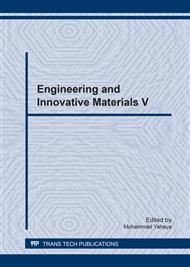[1]
P. Pasbakhsh, R. T. De Silva and V. Vahedi, The Role of Halloysite's Surface Area and Aspect Ratio on Tensile Properties of Ethylene Propylene Diene Monomer Nanocomposites, Int. J. Chem. Mol. Nucl. Mater. Metall. Eng. Vol. 8 (2014), p.1363–1366.
Google Scholar
[2]
R. Kamble, M. Ghag, S. Gaikawad and B. K. Panda, Halloysite Nanotubes and Applications: A Review, J. Adv. Sci. Res. Vol. 3 (2012), p.25–29.
Google Scholar
[3]
D. Rawtani and Y. K. Agrawal, Multifarious Applications of Halloysite Nanotubes: a Review. Rev, Adv. Mater. Sci. Vol. 30 (2012), p.282–295.
Google Scholar
[4]
F. Chiriaco, F. Conversano, E. A. Sbenaglia, S. Casciaro, S. Leporatti and A. Lay-Ekuakille, Cytotoxicity Measurements of Halloysite Nanotubes for Nanomedicine Applications, IEEE MeMeA 2014 - IEEE Int. Symp. Med. Meas. Appl. Proc. (2014).
DOI: 10.1109/memea.2014.6860126
Google Scholar
[5]
V. Vergaro, E. Abdullayev, Y. M. Lvov, A. Zeitoun, R. Cingolani, R. Rinaldi and S. Leporatti, Cytocompatibility and Uptake of Halloysite Clay Nanotubes, Biomacromolecules Vol. 11 (2010), p.820–826.
DOI: 10.1021/bm9014446
Google Scholar
[6]
J. Cervini-Silva, A. Nieto-Camacho, E. Palacios, J. A. Montoya, V. Gomez-Vidales and M. T. Ramirez-Apan, Anti-inflammatory and Anti-Bacterial Activity, and Cytotoxocity of Halloysite Surfaces, Colloids Surfaces B Biointerfaces Vol. 111 (2013).
DOI: 10.1016/j.colsurfb.2013.06.056
Google Scholar
[7]
M. Du, B. Guo and D. Jia, Newly Emerging Applications of Halloysite Nanotubes: A Review. Polym, Int. Vol. 59 (2010), p.574–582.
DOI: 10.1002/pi.2754
Google Scholar
[8]
Y. -F. Shi, Z. Tian, Y. Zhang, H. -B. Shen and N. -Q. Jia, Functionalized Halloysite Nanotube-based Carrier for Intracellular Delivery of Antisense Oligonucleotides, Nanoscale Res. Lett. Vol. 6 (2011), p.608.
DOI: 10.1186/1556-276x-6-608
Google Scholar
[9]
S. Casciaro, G. Soloperto, F. Conversano, E. Casciaro, A. Greco, S. Leporatti, A. Lay-Ekuakille and G. Gigli, Automatic Image Detection of Halloysite Clay Nanotubes as a Future Ultrasound Theranostic Agent for Tumoral Cell Targeting and Treatment, Conf. Rec. - IEEE Instrum. Meas. Technol. Conf. (2014).
DOI: 10.1109/i2mtc.2014.6860878
Google Scholar
[10]
A. D. Hughes, J. Mattison, L. T. Western, J. D. Powderly, B. T. Greene and M. R. King, Clin, Microtube device for Selectin-Mediated Capture of Viable Circulating Tumor Cells from Blood, Chem. Vol. 58 (2012), p.846–853.
DOI: 10.1373/clinchem.2011.176669
Google Scholar
[11]
E. Abdullayev and Y. Lvov, Halloysite Clay Nanotubes as a Ceramic Skeleton, for Functional Biopolymmer Composites with Sustained Drug Release, J. Mater. Chem. B Vol. 1 (2013), p.2894–2903.
DOI: 10.1039/c3tb20059k
Google Scholar
[12]
Q. Chen, Y. Zhao, W. Wu, T. Xu and H. Fong, Fabrication and Evaluation of Bis-GMA/TEGDMA Dental Resins/ Composite Containing Halloysite Nanotubes, Dent Mater. Vol. 28 (2012), p.1071–9.
DOI: 10.1016/j.dental.2012.06.007
Google Scholar
[13]
Y. Lvov, W. Wang, L. Zhang and R. Fakhrullin, Halloysite Clay Nanotubes for Loading and Sustained Release of Functional Compounds, Adv. Mater. Vol. 28 (2016), p.1227–1250.
DOI: 10.1002/adma.201502341
Google Scholar
[14]
P. Yuan, D. Tan and F. Annabi-Bergaya, Properties and Applications of Halloysite Nanotubes: Recent Research Advances and Future Prospects, Appl. Clay Sci. Vol. 112–113 (2015), p.75–93.
DOI: 10.1016/j.clay.2015.05.001
Google Scholar
[15]
M. J. Saif and H. M. Asif, Escalating Applications of Halloysite Nanotubes, J. Chil. Chem. Soc. Vol. 60 (2015), p.949–2953.
DOI: 10.4067/s0717-97072015000200019
Google Scholar
[16]
M. Liu, C. Wu, Y. Jiao, S. Xiong and C. Zhou, Chitosan-Halloysite Nanotubes Nanocomposite Scaffolds for Tissue Engineering, J. Mater. Chem. B Vol. 1 (2013), p. (2078).
DOI: 10.1039/c3tb20084a
Google Scholar
[17]
K. -S. Lee and Y. -W. Chang, Thermal, Mechanical, and Rheological Properties of Poly(ɛ-caprolactone)/Halloysite Nanotube Nanocomposites, J. Appl. Polym. Sci. Vol. 128 (2013), p.2807–2816.
DOI: 10.1002/app.38457
Google Scholar
[18]
Y. Chen, L. M. Geever, J. A. Kilion, J. G. Lyons, C. L. Higginbotham and D. M. Devine, Halloysite Nanotube Reinforced Polylactic Acid Composite, Polym. Compos. (2015).
DOI: 10.1002/pc.23794
Google Scholar
[19]
Y. Lin, K. M. Ng, C. -M. Chan, G. Sun and J. Wu, High-impact Polystyrene/Halloysite Nanocomposites Prepared by Emulsion Polymerization Using Sodium Dedocyl sulfate as Surfactant, J. Colloid Interface Sci. Vol. 358 (2011), p.423–429.
DOI: 10.1016/j.jcis.2011.03.009
Google Scholar
[20]
V. D. Prajapati, P. M. Maheriya, G. K. Jani and H. K, Solanki: Carrageenan: A Natural Seaweed Polysaccharide and Its Applications. Carbohydr, Polym. Vol. 105 (2014), p.97–112.
DOI: 10.1016/j.carbpol.2014.01.067
Google Scholar
[21]
L. Yu, K. Dean and L. Li, Polymer Blends and Composites from Renewable Resources. Prog, Polym. Sci. Vol. 31 (2006), p.576–602.
DOI: 10.1016/j.progpolymsci.2006.03.002
Google Scholar


